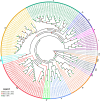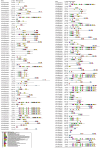Exploring the role of ATP-binding cassette transporters in tomato (Solanum lycopersicum) under cadmium stress through genome-wide and transcriptomic analysis
- PMID: 40171483
- PMCID: PMC11958947
- DOI: 10.3389/fpls.2025.1536178
Exploring the role of ATP-binding cassette transporters in tomato (Solanum lycopersicum) under cadmium stress through genome-wide and transcriptomic analysis
Abstract
ATP-binding cassette (ABC) transporters are integral membrane proteins involved in the active transport of various substrates, including heavy metals, across cellular membrane. In this study, we performed a genome-wide analysis and explored the expression profiles of ABC transporter genes in Solanum lycopersicum to identify their role in cadmium (Cd) stress tolerance. Several techniques were employed to determine the regulatory role of ABC transporters. A total of 154 ABC transporter genes were identified in the genome of S. lycopersicum, located on all 12 chromosomes. Comparative phylogenetic analysis between S. lycopersicum and Arabidopsis thaliana revealed several orthologous gene pairs, which were duly supported by the structural analysis of the genes by studying the exon-intron pattern and motif analysis. Collinearity analysis revealed multiple gene duplication events owing to intra-chromosomal and inter-chromosomal mutations. The cis-regulatory analysis identified several hormone-responsive elements suggesting that ABCs are actively involved in transporting hormones like ABA, SA, MeJA, auxin, and gibberellin. These hormones are known to combat a number of stress conditions, hence validating the role of ABCs in Cd stress. Under Cd stress, expression profiling demonstrated that several SlABCs exhibit significant transcriptional changes, indicating their involvement in Cd transport, sequestration, and detoxification mechanisms. Specific genes, including Groups 3 and 5 members, were upregulated under Cd exposure, suggesting their functional roles in mitigating Cd toxicity. The study revealed differential expressions of various SlABC genes encoding ATP binding cassette transporters, including the upregulation of several genes like Solyc08g067620.2, Solyc08g067610.3, Solyc12g019640.2, Solyc06g036240.2, and Solyc05g053610.2 in response to different concentrations of Cd. This study comprehensively explains the ABC transporter gene family in S. lycopersicum, emphasizing their critical roles in Cd stress tolerance. This study could prove useful in combating Cd stress not only in S. lycopersicum but also in other fleshy fruit plants; however, further advanced studies on specific pathways that lead to differential expression of the ABC genes are required to understand the mechanism behind tolerance to heavy metals fully.
Keywords: ABC transporters; Solanum lycopersicum; gene expression; heavy metals; phylogenetic analysis.
Copyright © 2025 Hashmi, Lubna, Bilal, Jan, Asif, Abdelbacki, Kim, Al-Harrasi and Asaf.
Conflict of interest statement
The authors declare that the research was conducted in the absence of any commercial or financial relationships that could be construed as a potential conflict of interest.
Figures









References
-
- Ali M., Shafiq M., Haider M. Z., Sami A., Alam P., Albalawi T., et al. . (2024). Genome-wide analysis of NPR1-like genes in citrus species and expression analysis in response to citrus canker (Xanthomonas axonopodis pv. citri). Front. Plant Sci. 15. doi: 10.3389/fpls.2024.1333286 - DOI - PMC - PubMed
-
- An L., Ma Q., Du J., Yu M., Li F., Luan J., et al. . (2019). Preliminary classification of the ABC transporter family in betula halophila and expression patterns in response to exogenous phytohormones and abiotic stresses. Forests 10, 722. doi: 10.3390/f10090722 - DOI
-
- Arshad A., Cîmpeanu S. M., Jerca I. O., Sovorn C., Ali B., Badulescu L. A., et al. . (2024). Assessing the growth, yield, and biochemical composition of greenhouse cherry tomatoes with special emphasis on the progressive growth report. BMC Plant Biol. 24, 1002. doi: 10.1186/s12870-024-05701-5 - DOI - PMC - PubMed
LinkOut - more resources
Full Text Sources

